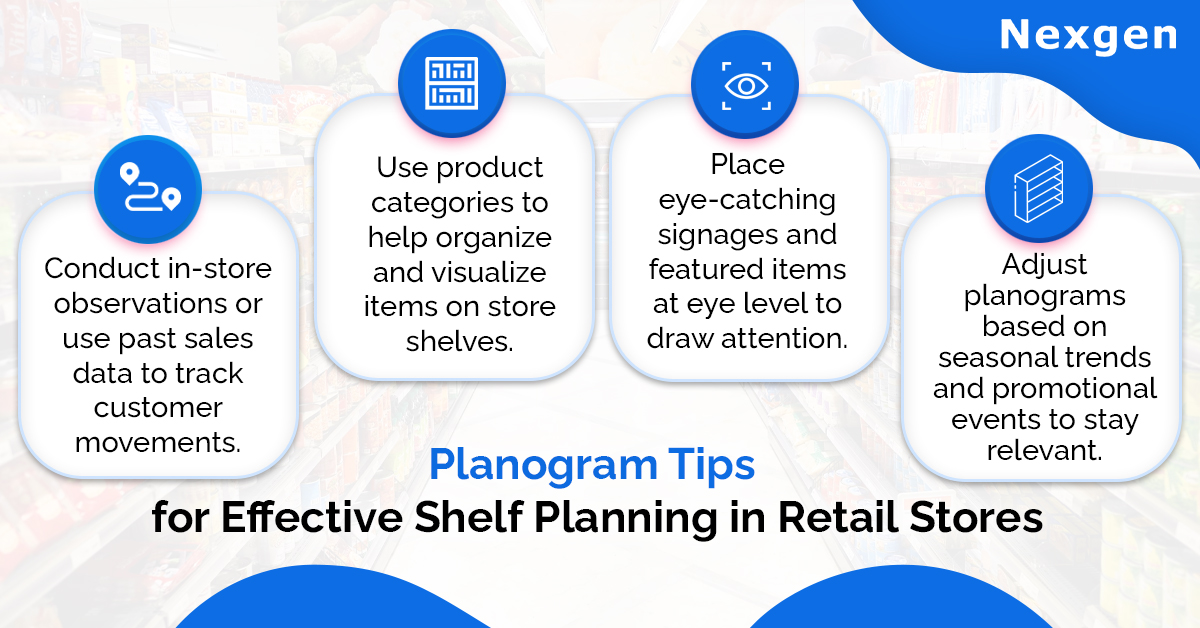In retail, the strategic arrangement of products can significantly impact the customer experience and sales. Shelf space planning solutions, such as planograms, visual diagrams that depict product placement on shelves, are essential tools for optimizing store layouts. Creating effective planograms can significantly boost your retail store's sales and enhance the overall shopping experience for your customers. Here are five top tips to help you create effective planograms for your retail store.

1. Understand your Customer’s Journey
Before diving into the technical aspects of a planogram, it is essential to understand your customers' shopping behaviors. Analyze how customers navigate through your store and identify the key areas where they spend the most time. Following are some tips before creating a planogram to boost sales:
- Conduct in-store observations or use past sales data to track customer movements.
- Identify high-traffic areas and place best-selling or cross-merchandising complementary items in these zones.
- Ensure that staple items are easy to locate, encouraging a smooth and satisfying shopping experience.
2. Leverage Data and Analytics
Data-driven decisions are critical in creating effective planograms. Utilize sales data, inventory reports, and customer feedback to inform your product placement strategy. Following are some tips for creating effective planograms:
- Analyze historical sales data to identify top-performing products.
- Use product categories to help in organizing and visualizing items on store shelves.
- Adjust your planograms based on seasonal trends and promotional events to stay relevant.
- Saves cost spent on visual merchandising and reduces chances of errors.
3. Adopt the Right Visual Merchandising Techniques
Effective visual merchandising can significantly impact customer perception and buying behavior. Use planograms to highlight key products and create visually appealing displays. Following are some tips for creating planograms to entice shoppers:
- Implement the rule of three: Group products in sets of three for a balanced and attractive display.
- Use color blocking to create a cohesive and visually stimulating arrangement.
- Place eye-catching signage and promotional materials at eye level to draw attention to the featured products.
4. Optimize Shelf Space and Product Placement
Maximizing your shelf space involves strategically placing products to ensure that they are easily accessible and visible to customers. Consider the following tips for effective shelf space planning:
- Place high-margin and high-demand products at eye level, where they are most likely to be seen.
- Group similar products together to create a logical flow and make it easier for customers to find what they need.
- Use end caps and checkout displays for impulse items and promotional products.
5. Regularly Review and Update Your Planograms
The retail environment is dynamic, and your planograms must be as well. Regularly reviewing and updating planograms ensures that they remain effective and aligned with current trends and customer preferences. The following tips will help you create an efficient planogram for retail stores:
- Schedule periodic reviews of your planograms, especially after major sales events or seasonal changes.
- Gather feedback from store staff and customers to identify areas for improvement.
- Use planogram software to make quick adjustments and track the impact of changes on sales performance.
Overview of Nexgen POG
Nexgen POG is a robust and user-friendly cloud-based visual merchandising tool. It is designed for quick and efficient planogramming with minimal effort. Planogram in retail can be designed by easily dragging and dropping the products. The multi-device compatibility feature of POG allows you to obtain, share and edit planogram on any device, including your phone. It helps in designing store-specific planograms for increased product visibility and sales.
Get Your Free Trial Now!